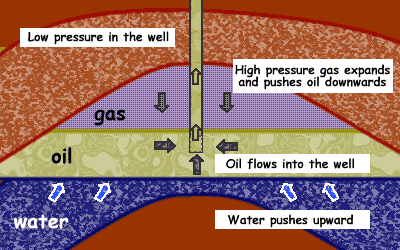We just learned what hydrocarbons are, we want to know where they come from. This article continues the series on Crude Oil.
Organic material, like algae and zooplankton, that have died millions of year ago and sank to the bottom of the ocean were slowly buried by silt and other organic material to form layers. Under the intense pressure and heat of the ocean floor a chemical decomposition, called pyrolysis, occurred. This process can be complicated, but basically the chemical energy that was in these living things when they died is broken down into hydrocarbons. Different time lengths, organic material, and conditions change the properties of the oil, giving us thousands of different kinds of crude oils from light and sweet oils like West Texas Intermediate (WTI) to heavy and sour crudes like Dubai’s Fateh.

- Light Crude Oil
The words “heavy” or “light” are used to describe of dense and viscous an oil is – just like it sounds. “Sour” or “sweet” refer to how much sulfur is in the oil (sour = higher sulfur content). The more sulfur in the crude, the more the oil must be refined to remove the sulfur which – if not removed – causes acid rain. West Texas Intermediate (WTI) is a relative easy crude to reform since it’s made of smaller molecules (and therefore less viscous and dense) and has little sulfur.
In the first half of the 1900’s, when Texas was the Saudi Arabia of oil, WTI was established as the standard by which other crudes would be judged. So when you hear on the news that oil prices have hit $100, they mean that WTI is selling for $100 per barrel. The Saudi crudes, which the USA buys a lot of, are cheaper since they’re generally heavier, more sour, and therefore harder to refine. They’re also cheaper since there’s more heavy crude left in the world than light crude. After the organic material has become oil and gas, they rise until they become trapped in a geological formation like the pocket shown below.

- Oil Formation
Extracting oil from the earth is a difficult process and the earth is running out of easy-to-access oil. Usually less than 70% of the oil in a reservoir can be extracted by current cost effective techniques, so we’re not even getting all of the oil out of the best wells. Some energy companies are trying to find new ways to reach oil in existing wells using a class of techniques called Enhanced Oil Recovery (ERO) but that’s a topic for another post. The image below shows the red area from the image above. Most oil is less dense than water so it floats on top of water (like grease sits on top of water when you add water to a dirty frying pan). On top of the oil layer is usually natural gas. A hole is dug down to this layer and a pipe is inserted. The oil is then pumped out of the ground.
That’s the basics of how crude oil is created and removed from the ground. Next we’ll take a look at how crude oil is turned into useful products like gas, motor oil, and jet fuel.



